Discovering the Five Poussin’s in ‘Gallery 617’
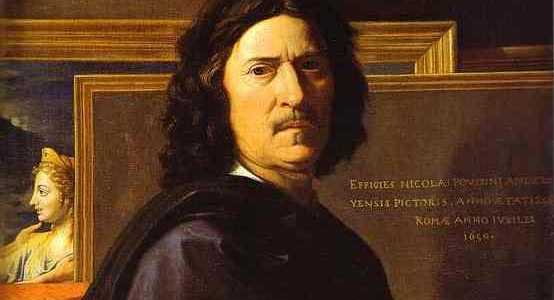
In the period of the high Baroque several artists emerged that would make their mark on the western painting tradition for centuries to come. Most of these influential masters of the Baroque were situated in Rome as the religious capital of the Catholic-Christian world and enjoyed the benefits of wealthy patrons like the Barberini family and their circle. Nicolas Poussin is one of the unique examples of this group who existed for significant periods within Rome, imbibing the air of excitement in artistic and cultural production, producing his own vision of a Baroque French Classicism.[1] He would arrive in Rome in 1624 to embark on an ambitious career that would then return him to France in 1940 for several years, only then to return to Rome. When in France, during the short three-year period that he spent before his return to Rome Poussin was taken in by Louis XIII and given the title of First Painter in Ordinary. Upon returning to Rome Poussin then produced paintings for prominent collectors in France, such as Chantelou who was so integral to the career of both Poussin and the great sculptor and architect Gian Lorenzo Bernini.[2] It is here during the progress of these movements between France and Rome that further explanation must be given and inquiry must be made. For it is against the more dramatic and flamboyant painting styles of the Baroque that Poussin hones his tight rationalist and classicizing compositions.
Poussin’s oeuvre shows the decided marks of an artist immersed in antique scholarship, dedicated to the classical texts and cultural products of ancient Greece and Rome, we can look to his images as reflective spaces for the contemplation of a philosophy in motion. It is productive to trace out two events that reinforce this passion for antiquity which so greatly influences Poussin’s approach to painting. While struggling to make his first venture to Rome and still currently tied down by uncompleted commissions in Lyon and Paris, Poussin engages in a productive relationship with Giambattista Marino.[3] While employed by Marino, the court poet for Marie de Medici, Poussin creates illustrations for his poem Andone (untraced) and, significantly, he produces illustrations for an edition of Ovid’s Metamorphoses. While working on the Metamorphoses prints he gains access to Rome through Marino; so in the midst of working on illustrations for one of the great works of antique literature, he is immersed in the environs of Rome with all its lingering Renaissance air of fascination and passion for the ancients. From here Poussin will distinguish himself as a painter dedicated to a strict academic style, aligning with Domenichino and the Carracci influence of tight, balanced and naturalistic compositions with emphasis on narrative cohesion.[4]
I argue that Poussin is guided in his work by a particular vision of Ovidian Stoicism, through this philosophical lens he creates both theological and mythological images that demonstrate the importance of the Stoic mentality, and the power of the painting to present a reflective space for intellectual engagement and contemplation. In this paper, I will look to explore several paintings from the Metropolitan Museum’s collection to point to the Stoic thematics that suffuse their form and content: emphasis will be placed on thematics of death and rebirth, struggles of fortune and fate, the taming of the passions and the human will towards freedom.[5] Looking to five large oil paintings housed at the Met, I will be able to proceed through from the early to mid and then later years of Poussin’s painterly evolution. The five pieces all reside within ‘Gallery 617’ of the Met and so can be seen together for all their complex similarities and differences. Works under examination are as follows in chronological order: The Rest on the Flight into Egypt (1628), The Companions of Rinaldo (1633), The Abduction of the Sabine Women (1633-34), Saint’s Peter and John Healing the Lame (1655) and The Blind Orion Searching for the Rising Sun (1658).
Central to this collection of works is their assembled presence in the gallery, together they show a huge range of subject matter that intersperses the biblical narrative with the mythological narrative, and in the unique case of The Companions of Rinaldo a rare mix of the two, a vision of theologico-mythology.[6] As scholar Victoria Curtin Gardner has shown in her dissertation on the subject, the cultural world of seventeenth-century Rome to which Poussin belonged was a hotbed of overlapping discourses between theology, philosophy and the nascent scientific revolution. One central philosophical/ theological hybrid that would have weighed heavily on Poussin’s antiquarian sensibilities was Neostoicism: “the combination of Christianity and classical stoicism that emerged in sixteenth and seventeenth-century European intellectual circles.”[7]
It is Gardner’s argument that the degree to which this Neostoicism inflected the work of Baroque painters with specific regard to the late work of Claude Lorrain and Poussin was due to the commission and the charismatic influence of the patron. However, it is my contention that in Poussin we see an artist who is also a scholar, who has taken throughout his career nodes and kernels of antique history, culture and philosophy and woven them into his own unique vision. For Poussin the Stoic vision starts with Ovid and it is born along and reinforced by the concentration on a formal language that best renders the narrative drama, creating a bridge between word and image.
Poussin is above all a narrative painter, through the refined organization of his compositions he attempts to draw out a narrative within the space of a single tableau. His precedent stands as a great influence on the formation of French academicism and the erection of a hierarchy of value for the subject matter of painting. Arguably he also influenced the privileged position painting would take within the fine arts for the next two centuries. Wrapped up in all of this is Poussin’s chief role as the ‘philosophical painter’ and the power he saw within the painted surface to convey the narrative message.[8] This is also to say that he had a deep respect for the narrative forms of the ancients, and this was heavily reinforced by the socio-cultural atmosphere of Rome during the Baroque period. For with the early onset of the scientific revolution and the enlightenment, which scholars now date to as early as 1620, there was an empirical turn towards the mysteries of the natural world which the ancients had been shown to so meticulously study and contemplate.[9] However, the socio-cultural atmosphere of Rome and France were still caught up in the centrality of the divine, the supremacy of the church and the position of philosophy was thus shot through with theological aspects as well. With Poussin we get the perfect nexus of all these issues, reconciling the rising positivism with the wisdom and fascination of ancient scholarship, and the still pervasive influence of the church.
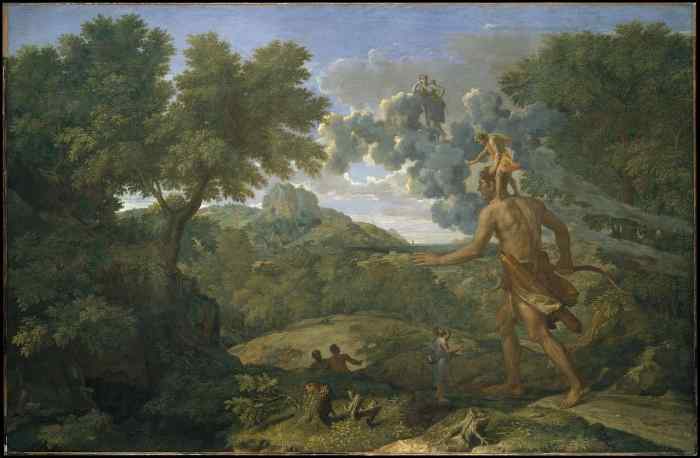
Turning to the latest image in our series first, it is clear that The Blind Orion is a mature product of Poussin’s developed style in both form and content. We find Orion in mid-action, striding with full force towards the rising sun, all the elements of the mythic tale are here before us in the sweeping naturalistic landscape Poussin presents. As the Carracci before him, Poussin would have created this landscape using carefully drafted sketches and studies from nature.[10] The blind Orion is guided towards the rising sun by his companion Cedalion who stands on his shoulders, the sun can be seen just emerging from a sweep of dissipating clouds above the distant sprawl of the mountainous landscape.
The rising sun will bring a cure to Orion’s blindness, a punishment cast on him by the father of Princess Merope, after he had attempted to rape her. As is the case in many of Poussin’s mythological scenes the ubiquitous presence of the gods is always included. Here the goddess Diana watches from the clouds above, seeming to relish the last struggling moments of Orion’s blindness, she nonchalantly rests on the sweep of clouds that stand in the way of the sun’s rays.[11] The image is immediately a calculated statement on the thematic of folly, fortune and fate. It is here that the Stoic mind can contemplate the repercussions of an impassioned nature, when human will fails against the onslaught of the pleasure-seeking faculties. However, per scholar Ernst Gombrich, there is a deeper reading and possibility to the painting that proves to show overlapping thematics, all central to the Stoical/ Neostoical cosmology.
Gombrich rightly traces back the possible sources for Poussin’s reading and thus iconographical configuration of the scene. From one perspective, it was certainly a painting inspired by an account of ancient frescoes on the same subject given by the ancient Greek rhetorician and satirist Lucian.[12] Gombrich shows that a more direct literary source for Poussin would have been Natalis Comes’s reference book on classical mythology. The significance here is that this work sought to show how “all the doctrines of Natural and Moral Philosophy were contained in the fables of the ancients.”[13] Thus it is possible to read into the image a more complex demonstration of the mythological tale as an allegorical play on the “cyclical and mutual generation and destruction of the elements.” Here we see the various players standing in for elemental forms which transmute with the cycle of each new day.
This opens up the painting to much more complex readings even if we choose to bypass what scholar Martin Kemp has called “Conti’s horribly tangled ‘scientific’ reading.”[14] For Poussin’s rendering opens up a certain freedom of interpretation and illustrates the diverse potential of the mythological tale to shift meaning based on its exegesis. The painting becomes a space to contemplate this blighted figures chase after the new day, hoping for regeneration and renewal. As Kemp states with regard to Poussin: he “insisted on the rational basis of art as visual knowledge. He defined the proper role of painting as a form of rational scrutiny, distinct from mere seeing and passive imitation. It was to reveal in form and content the underlying order of the created world and the integral position of humans in the divine system of nature.”[15]
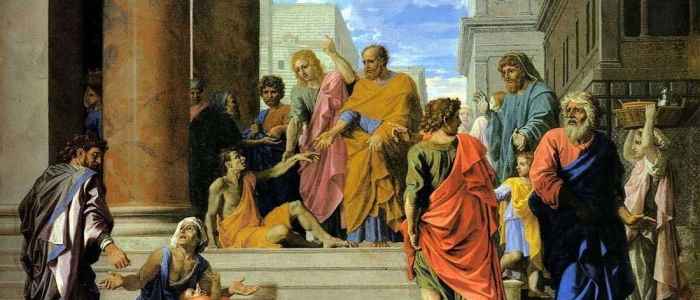
It becomes clear that for Poussin the history painting had the power and potential to instruct and in the hands of the artist philosopher, reveal the deeper truths of human existence within the natural order. Significant here are the networks of scholarship that wove around Poussin’s own critical awareness of ancient art and literature, the Neostoicism of the intellectual circles he moved in best demonstrates this.[16] It was no singular commission or patron that brought about the imbrication in Poussin’s work of Christian divinity, Stoic philosophy and antique scholarship, but rather the confluence of forces that were shaping Western thought during the high Baroque. The force and influence of Renaissance rationalism is carried over into the formal compositional order of Poussin’s canvases, yet there is an evolution of the style wherein the balance, proportion, ratio and harmony of the piece is infused with expressive immediacy of the narrative tableau. This comes through with the next piece in the Met gallery, going back three years but still within the later period of Poussin’s mature style, Saints Peter and John Healing the Lame Man (1655).
As Poussin did with his epic series of the seven sacraments just 6 years earlier, he creates a rational and organized classicist tableau out of a miraculous biblical event.[17] Scholar Richard Verdi discusses the subversive nature of this move, especially at a time in the Baroque era when scenes of the miraculous and divine were being rendered with such ecstatic drama. Verdi argues that “the subjects which form the basis of the Sacraments are treated by Poussin not as a series of religious mysteries but as a series of moral lessons.”[18] Verdi continues referring to an earlier study done by Baroque scholar Walter Friedlander: “This idea was most succinctly summarized by Friedlander when he wrote: ‘all the actions in the Sacraments, from Baptism to Extreme Unction, acknowledge the wisdom or higher sagesse which provides the believer with armor against the tempests (or the ‘tricks’) of Fortune.’”[19]
In the healing of the lame man, the secular, ethical and philosophical elements strongly reinforce a similar reading, creating a fusion between the Christian iconography and Stoic thematics of the rational mind as “weaponry” against the turns of fortune and tricks of fate. The scene is perfectly carved out using the geometry of the rectilinear architectural elements, the temple entrance and steps flow out from the left and form the core of the action. The massive forms of the temple columns frame announce the presence of the antique as the piazza tiles out front move into the viewer’s space. There are three groupings of figures that all seem to be given similar weight and value, the only thing setting Peter and John apart are their position at the center.
Each group appears to demarcate a different approach to the problem of the beggarly and the lame, one man slips a money piece to a blind woman beggar to the left quickly passing her by. To the right, we have those who show no concern at all, carrying on in the endless procession of time, two men pass each other casually parting ways but in the center Peter and John actively engage the lame man. In the biblical tale, Peter invokes Christ’s name and tells the man to rise, yet here we see two men in classical garb that appear more as philosophers than saints, the whole scene belonging more to Raphael’s School of Athens than biblical writ.[20] The saints appear to be appealing to him with the pure logic of a rational appeal, arguing that his ailment is perhaps one of the mind or the will.
Such a rendering of a biblical miracle falls in line with Poussin’s use of mythology, biblical tales and ancient history as so many “autres histoires,” that is literally other or different histories to pull from to create his narrative tableaus.[21] This all pulls toward the Stoic ideal of preparedness, tempering oneself mentally and thus physically towards the various tempests bound towards man. These are the turns of fortune that can come from man’s struggle against himself, nature’s sublime force overall and the hand of the divine. For this understanding Poussin certainly drew from such leading Neostoical minds as Pierre Charon, Corneille and Descartes.[22] On a more personal level it was the dynamic and often unprecedented relationships he had with his patrons that allowed him access to rare and extensive libraries as well as movement within the intellectual inner circles.
Certainly, as scholar Victoria Curtin Gardner points out in her study on Cardinal Massimo and his connections with both Poussin and the painter Claude Lorain, there was a close bond between the Cardinal and Poussin. Massimo’s library was extensive and housed some of the greatest historical archives but also newer studies and treatises on the arts, literature and science.[23] However this was only one figure in a list of many others, another influence Paul Freart de Chantelou, an impassioned patron and collector of Poussin’s work, who commissioned the second set of sacramental paintings from Poussin in 1648.[24] It is also necessary to return to one of Poussin’s first and perhaps most formative patron relationships that with the court poet Giambattista Marino who had originally enabled Poussin’s entry into Rome. Here we have the alignment of young Poussin with an influential member of the literary circle in Marie de Medici’s Baroque era court.[25] With Poussin’s assignment by Marino to the Metamorphosis illustrations, this is arguably an important early influence on the painter’s complex and evolving relationship with the narrative history painting form.
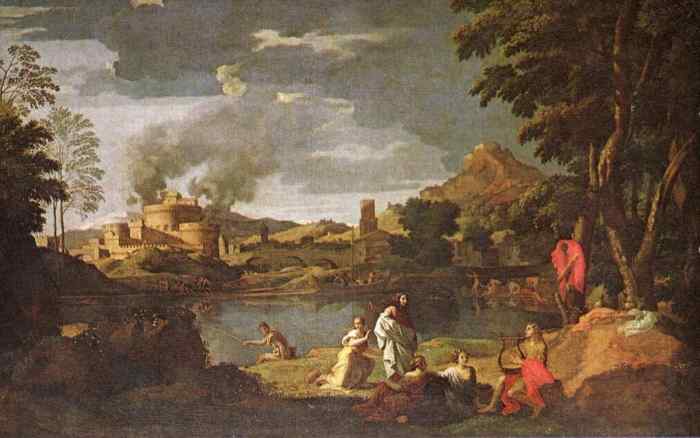
The impact and influence of Poussin’s relationship with Marino and the resulting commissions are evidenced in the continual return that Poussin makes throughout his career to key tales and scenes from Ovid’s Metamorphosis.[26] And here, once again we can make another connection to the distinctly Humanist Stoical vision that Poussin saw in Ovid’s series of mythic stories. For his own critical sensitivity to the overt nature of Ovid’s work as a rich platform through which Stoic thematics are expressed, provides a way to understand how this technique carried over to even the most Christian religious subject matter. Taking up the earliest piece in the group of paintings at the Met, the Rest on the Flight into Egypt (1627), the reference to Antique literature, culture and philosophy can be viewed with a specific direction towards the Neo-Stoical merger of Christianity and Stoicism.
The depiction of the rest taken by the holy family on their flight into Egypt is a very unusual one when compared to past iterations by Renaissance masters or even by early Baroque artists like the Carracci or even Caravaggio. Two main differences catch the viewer’s eye and signify a movement towards a very different reading of the conventional biblical scene. First is the appearance of the small putti scattered throughout the scene, playfully fussing over the baby Jesus and Mary, second is the degree to which Joseph is scene removed from this first grouping, contemplatively pouring over a large text. The Putti and their relationship to the sweeping grandeur of the landscape behind immediately calls up the Bacchanals that Titian was creating earlier in the century and that Poussin would have seen upon arriving in Rome.[27] This would have been a provocative move for the artist to so overtly merge imagery quoted from an earlier rendering of Greek mythology, especially the Bacchanal, and the holy family in their escape from Herod’s murderous campaign.
However, Poussin is able in this image to include the rollicking group of putti by their significance in the trajectory of New Testament events. These putti would represent to any discerning eye of the Baroque period, the unbaptized innocents that were slaughtered by Herod’s bloodthirsty campaign. In this way, as scholar Diane De Grazia states in her study on the subject, “they are unusual in a Holy Family context and, indeed, almost never appear in this context in Italian art of the sixteenth and seventeenth centuries…,” however, “once the babies are recognized as the Holy Innocents, the first martyrs who gave up their lives for Christ, we understand their inclusion in this scene.”[28] And so the merger and overlap between a Christian and Greek mythological content appears once again as Poussin breaks down the distinction between the two, showing them as “other histories,” contemplative scenes of human drama. But how then does this align with the continual evidence of a Neo-Stoical thematic, and where does the individual find space within the scene to meditate on the human condition and the Stoic cosmology? It lies, I argue, in the convergence of these three unlikely components: the meditative recessed figure of a reading Joseph, the putti now seen as martyred innocents, and the poetic landscape that provides the stage set for the scene.
Of course, the poetic landscape is not unprecedented and shows the influence of Annibale Carracci’s early depiction of the same scene, but taken together these elements form the ground for a deeper allegorical reading of the piece. For, with the right kind of studied gaze, the scene turns from holy mystery to an allegorical treatise on mortality, time’s transient passage, and the force and flow of the natural world. The putti flutter around in the landscape as a protective force guiding the safe passage of the holy family, this is to acknowledge the fragility and vulnerability of human life and the necessity for divine intervention.[29] As martyred innocents returned to execute the bidding of the divine, the putti also stand in as weighted symbols of death and rebirth especially posed against the sweep of the poetic landscape. Connecting the analysis of The Rest on the Flight into Egypt, with scholar Paul Barolsky’s study of Poussin’s Metamorphosis paintings from throughout his career, such as the Realm of Flora and the Birth of Bacchus, is instructive here and demonstrates some key overlaps. Barolsky, through his analysis of key images points directly to the ways Poussin draws out the Stoic thematics from the Ovidian tales, emphasizing the transient flow of time and finite human life. As Barolsky argues, Poussin sees in Ovid’s portrayal of nature’s ever-changing forms, “the Stoic doctrine, which dwells on the flow of all created things, the understanding that, as a thing comes to be it is swept away in turn.”[30]
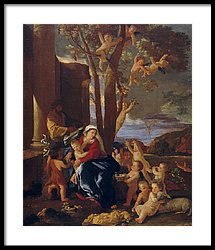
Thus when looking to the landscape that enwraps the holy family, the deep gray of the storm clouds moving in across the brilliant blues and purples of the receding skyline it is clear that here as in the Metamorphosis depictions, Poussin tells the larger Ovidian story: “his larger story is that of flux, of ongoing transformation, of death and rebirth, which calls to mind the stoic cycles of nature.”[31] To make a provocative comparison it is quite rational to align Poussin’s Realm of Flora with the imagery shown in ‘the Rest,’ this is underlined in Barolsky’s reading of the former:
As a meditation on mortality, Poussin’s painting is necessarily a reflection on the passage of time, which is magnified by the enframing flight of Apollos’s chariot above. The flow of time is further marked by the dance of Flora and the band of putti behind her, who we might say in the language used to describe another of Poussin’s pictures, ‘dance to the music of time,’ in tempo with time itself as it passes before our very eyes.[32]
My goal here is to point up the parallels between Mary and Flora’s monumental female presence in each painting and the attachment of playful putti in both, all set in the poetic landscape symbolic of times inescapable transience. Further, to look at the figure of Joseph set into the decaying architectural ruins that frame the left of the Rest on the Flight into Egypt, is to reinforce the subtle construction of Stoical thematics within a Christian religious narrative. Joseph is set apart, immersed in a large text that at once defines him as a rational philosophical mind in contrast to the playful scene of women and children, and set against the decaying ruins further shows the passage of time. Recalling the words of the Stoics, of which Poussin was more than aware, two axioms seem to permeate the scene on the whole: “loss is nothing else but change, and change is nature’s delight,” but also, “each separate thing is but as a grain of sand in comparison with Being,…a single screw’s turn in comparison with Time.”[33]
Moreover, the significance of theatricality and the poignancy of the dramatic tableau remains within Poussin’s work, for these are the characteristics that mark and define the Baroque. However they’ve been carefully subdued, balanced and turned towards the Neo-Stoic temperament; indeed, they’ve been instrumentalized towards the meditative. Some scholars have even gone as far as to contend that Poussin represents a kind of anti-Baroque because of the emotional reserve of his images, the paired down and strict classicizing nature of his approach.[34] Scholar Richard Verdi along with others has argued that there is a nascent modernity illustrated in his later body of work, where he leans towards a kind of abstraction, using certain images like Holy Family on the Steps, as opportunities for formal experimentation.[35] These paintings and their preparatory sketches show Poussin focusing in on certain relationships between form that presage and would be hugely influential to major modernist figures like Cezanne and the post-impressionists.
However, this supposedly ‘Modernist tendency’ towards the treatment of formal relationships in abstract terms, also demonstrates the Stoic doctrine of the rational mind conquering and structuring the irrational world. This at heart is the topic of free will and man’s ability towards self-governance, issues hotly debated during the high-Baroque when the tension of the Reformation had eased and once again issues of freedom were revisited.[36] Entertained in French theater by neo-classical dramatists like Racine and humorists like Moliere, and subject to intellectual discussion by Descartes and Pascal, issues of man’s free-will and fate were ever present.
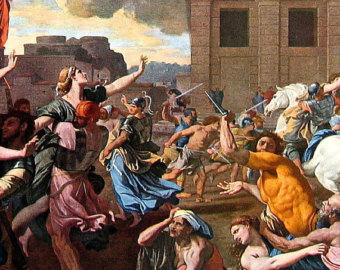
Of course, this subject of free-will and fate plays heavily on Stoical thematics as well, for in Stoic philosophy man is viewed as able to circumnavigate turns of fortune and the course of fate through knowledge and self-discipline.[37] This all plays out within the most dramatic piece within the Met gallery, a veritable tableau of theatrical staging in Poussin’s unique Baroque vision, The Abduction of the Sabine Women (1633-34). Within this work Poussin breaks up space using certain dynamic groupings of figures, he details the more gruesome elements of the barbaric conquest through which Rome was repopulated by using these groupings. In the background and mid-ground, structuring the piece, is the architectural facades of his beloved ancients, the classicizing architectural stage set gives a unity and balance to the composition.[38] In many ways a tableau of barbarity is rationally reordered and presented as a psychological meditation on the violent turns of fortune perpetrated by man against his neighbor.
Romulus stands between the columns of a great architectural colonnade calmly watching over the proceedings with an imperial grandeur, wearing the red cloak of royalty. His stance and position evoke the necessity of the barbarous act for the foundation and continuation of the Roman line during the mythic first generation of Roman society. There is a definite rational and didactic temperament in the depiction that speaks to the Stoic mentality of order, control and critical perception. This comes through to a greater extent when compared to Pietro Da Cortona’s piece of about four years earlier, wherein the figures are made to perform a kind of lyrical dance, creating a rhythm that pulses with a lush eroticism across the composition.[39] The architectural elements are used more as ornamentation and the vegetation is loosely depicted with a supple richness that makes light of the historical content, overall a treat for the eye but in definite opposition to Poussin’s studied compositional balance and harmony.
Poussin’s depiction of the abduction really engages in the brutality of the scene: women posed in different stages of emotional despair are carried off by Romulus’s men, there are babies thrown to the ground and an old woman gestures in agony. One grouping of figures to the right and front of the canvas creates a perfect pyramidal structure, drawing the eye around through the action of the Sabine man defending against the abduction of his wife and the dagger drawn by the Roman male. For the Neo-Stoic eye, during the high Baroque, this would serve as the perfect ensemble of content and form illustrating a critical scene in the mythic history of the great ancient civilization. Despite the careful rendering of emotion in each grouping, they are all so many pieces in the studied rational order of the whole. Poussin seems to capture the moment of anti-climax when the struggle has already been borne out by the Romans. The viewer is able then to register the scene as a historical case wherein the individual was surrendered up to the larger course of Roman civilizations development.
It seems only relevant to call up the great Stoic philosopher Epictetus and his lessons on tempering oneself to the harsh realities of the world with a rational Stoic apathy. Specifically, Epictetus speaks in his Enchiridion on the need to understand the nature of ‘things’ and to distance oneself from an attachment to material possessions and even human relations, for in time they will all be swept away.[40] As Epictetus states, “with regard to whatever objects give you delight, are useful, or are deeply loved, remember to tell yourself of what general nature they are…if you kiss your child, or your wife, say that you only kiss things which are human, and thus you will not be disturbed if either of them dies,” and in another passage he further instructs the Stoic mind to “never say of anything, ‘I have lost it’; but, ‘I have returned it.’ Is your child dead? It is returned. Is your wife dead? She is returned.”[41] Statements perfectly apt here for a scene of dispossession and a subtle contemplation of fate, barbarity and civilization.
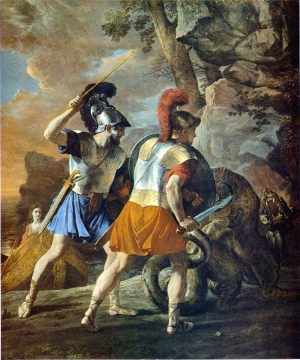
In closing, the last image of the five, The Companions of Rinaldo (1633), presents one more interesting thematic which ties together the other Stoic themes of mortality, transient time and fortune/ fate. This is the thematic of heroism, bravery and human agency in the face of all that conspires against man’s success and sense of content. Above all the Stoics and thus Poussin were highly conscious of the strength of the rational mind to conquer adversity and to stave off the calamities brought down by man, god and nature alike. The awesome power of nature and her undying cyclical patterns were much revered and meditated on but the Stoics also believed in man’s overriding will and agency.[42] So, here, as a proper end to the group of images in the Met, it is instructive to see this vision of heroism and bravery in the face of mythic adversity.
Once again Poussin draws from a literary source to create his narrative tableau, conquering the gap between word and image, and attaining to the true purpose of art put forth by Hegel, art as the sensuous expression of the idea. Taken from Torquato Tasso’s epic poem on the Christian crusades titled Jerusalem Delivered (1580), the scene depicts two Christian knights as they confront the dragon that blocks their way from rescuing the crusader Rinaldo from a Pagan Sorceress.[43] True to form, Poussin has classicized these medieval figures dressing them in the garb of Roman soldiers, the scene is also close cropped on a rocky mountain cliff with the poetic landscape receding to the left. The painter attempts to link the mythicized struggle of the crusaders, constructed by Tasso, to the mythic tales of his “beloved Ancients.”[44] The figures of the Christian Knights are poised in a perfect contrapposto calculating the movements of the beast that lays before them. Making myth of the crusade which was a campaign fought not against dragons but against pagan communities, appears as the perfect link between Stoic and Neo-Stoic where the Christian theological worldview is reconciled with the Stoic cosmology.
Thus, it becomes clear that Poussin is guided in his work by a unique vision of Stoicism. Through this philosophical lens, he created both theological and mythological images that demonstrate the importance of the Stoic mentality, and the power of the painting to present a reflective space for intellectual engagement and contemplation. This ultimately is the lesson that Poussin drew from Ovid’s epic collection of mythic tales, it is through narrative as a window onto the mythic/ historical past that the Stoic mind can contemplate the nature of existence and the nature but also the order of ‘things.’
I have explored several paintings from the Metropolitan Museum’s collection in order to point to the Stoic thematics that suffuse their form and content: emphasis was placed on thematics of death and rebirth, struggles of fortune and fate, the taming of the passions and the human will towards freedom. Looking to the five large oil paintings housed at the Met, Poussin’s painterly evolution unfolds before us as he moves from the a subtler to overt use of classicizing and philosophical elements. All residing within ‘Gallery 617’ of the Met, these five pieces, seen together, create a visual push and pull and so can be understood for all their complex similarities and differences. It also becomes clear from the juxtaposition of these pieces that Poussin sought to elevate painting to a new position of grandeur through his dedication to a calculated precision in rendering the narrative scene. Innovative and provocative Poussin stands as a testament to the benefits of a truly academic painting, a vision of artistic production born out of a thorough emersion in classical scholarship, contemporary study and philosophical perception.
Works Cited
[1] Poussin.org/biography
[2] Anthony Blunt, Nicolas Poussin: 1594-1665, (New York: Bollingen Foundation Press, 1967).
[3] Anthony Blunt, “Poussin and His Circle at Rouen,” The Burlington Magazine 103 (Burlington Magazine Publications Ltd., 1961): 352.
[4] Peter Heehs, “Narrative Painting and Narratives about Paintings: Poussin Among the Philosophers,” Narrative 3(Ohio State University Press, 1995): 215.
[5] Victoria Curtin Gardner, “Cardinal Camillo Massimo, Nicolas Poussin, and Claude Lorrain: A Study of Neostoic Patronage in Baroque Rome,” PhD Dissertation
[6] Met.org/collection
[7] Gardner, 6
[8] Heehs, Narrative Painting, 219
[9] E.H. Gombrich, “The Subject of Poussin’s Orion,” Burlington Magazine 84(Burlington Magazine Press, 1944): 38.
[10] Martin Kemp, “Exhibition: Ancient Orders of Nature,” Nature 451(Nature Publishing Group, 2008): 525.
[11] Kemp, Exhibition, 525
[12] Gombrich, The Subject, 39.
[13] Gombrich, 40.
[14] Kemp, 525.
[15] Kemp, 525.
[16] Gardner, 8-10
[17] Richard Verdi, “Poussin and the ‘Tricks of Fortune’.” The Burlington Magazine 124(Burlington Magazine Publications Ltd., 1982): 680.
[18] Verdi, Poussin, 681.
[19] Verdi, 683
[20] Met.org
[21] Heehs, 221
[22] Paul Barolsky, “Poussin’s Ovidian Stoicism.” Arion: A Journal of Humanities and the Classics 6(Trustees of Boston University, 1998): 5.
[23] Gardner, 7.
[24] Verdi, 680.
[25] Blunt, Nicolas Poussin.
[26] Barolsky, Poussin’s Ovidian, 4.
[27] Moma.org
[28] Diane De Grazia, “Poussin’s “Holy Family on the Steps” in Context,” Cleveland Studies in the History of Art 4(Cleveland Museum of Art, 1999):31.
[29] De Grazia, Poussin’s ‘Holy Family, 32.
[30] Barolsky, 4.
[31] Barolsky, 8.
[32] Barolsky, 7.
[33] Seneca, The Stoic Philosophy of Seneca: Essays and Letters of Seneca, 1968(Penguin Press).
[34] Heehs, 211.
[35] Richard Verdi, “The Modernity of the “Holy Family on the Steps,” Cleveland Studies in the History of Art 4(Cleveland Museum of Art, 1999): 99-102.
[36] Heehs, 213.
[37] Epictetus, and Thomas W. Higginson, The Enchiridion, 1955 (New York: Liberal Arts Press).
[38] Baroque book
[39] Baroque book
[40] Epictetus, Enchiridion.
[41] Epictetus.
[42] Seneca.
[43] Met.org
[44] Blunt, 353.
Bibliography
Barolsky, Paul. 1998. “Poussin’s Ovidian Stoicism.” Arion: A Journal of Humanities and the Classics (Trustees of Boston University) 6 (2): 4-10.
Blunt, Anthony. 1961. “Poussin and His Circle at Rouen.” The Burlington Magazine (Burlington Magazine Publications Ltd.) 103 (701): 351-353+355.
Blunt, Anthony.1967. Nicolas Poussin: 1594-1665. New York: Bollingen Foundation Press.
Grazia, Diane De. 1999. “Poussin’s “Holy Family on the Steps” in Context.” Cleveland Studies in the History of Art (Cleveland Museum of Art) 4: 26-63.
Gardner, Victoria Curtin. “Cardinal Camillo Massimo, Nicolas Poussin, and Claude Lorrain: A Study of Neostoic Patronage in Baroque Rome.” PhD Dissertation. Intro, 1-20.
Gombrich, E.H. “The Subject of Poussin’s Orion.” Burlington Magazine 84(Burlington Magazine Press, 1944): 37-41
Heehs, Peter. 1995. “Narrative Painting and Narratives about Paintings: Poussin Among the Philosophers.” Narrative (Ohio State University Press) 3 (3): 211-231.
Kemp, Martin. 2008. “Exhibition: Ancient Orders of Nature.” Nature (Nature Publishing Group) 451: 525.
Poussin.org. Biography. www.poussin.org/biography
Verdi, Richard. 1982. “Poussin and the ‘Tricks of Fortune’.” The Burlington Magazine (Burlington Magazine Publications Ltd.) 124 (956): 680-685.
Verdi, Richard. 1999. “The Modernity of the “Holy Family on the Steps”.” Cleveland Studies in the History of Art (Cleveland Museum of Art) 4: 96-111.
Blind Orion Searching for the Rising Sun, 1958, Oil on Canvas
The Abduction of the Sabine Women, 1633-34, Oil on Canvas
Saints Peter and John Healing the Lame Man, 1955, oil on Canvas
The Rest on the Flight into Egypt, 1627, Oil on Canvas
The Companions of Rinaldo, 1633, Oil on Canvas
What do you think? Leave a comment.











I do respect these works because of their historical background and all that but I am a man of modern times and art is not the same as history.
Paintings simply records a particular point of view which was reality back then. Today the reality is different and that’s why art is different as well.
And I think when talking about such paintings we are not talking about art but about artistic cliches.
It’s worth spending an entire day just in the Poussin rooms in the hall. His work richly rewards attention, but reveals itself at its own pace. A magician of art, and a true master.
I think magician is a good way to put it, his paintings certainly have a type of magic allure, a shimmer of color, pose and beauty. I’ve spent probably too much time gazing at these works, but there is always something new I find and something rewarding in the act of looking!
Nicolas Poussin was a great painter, with smart hidden messages.
Definitely, the more I studied his career and life, I found just how much of a philosopher and intellectual he really was.
Awesome article. Good one.
Poussin is known for moving away from the classicising narrative and has often been interpreted as an experimentalist.
I know all the intellectual reasons why I should like Poussin but his work leaves me cold: dead fish.
Art appreciation is not, and never will be, objective, And thank God, or whoever, for that.
Great lecture, thanks! I’ll watch these painting very differently now.
Poussin seems to me very like Cy Twombly–or rather they are similar with immediate and eventual impressions reversed. Twombly’s poise, thoughtfulness and literariness only reveal themselves slowly, just like Poussin’s intensity.
For me he was an aquired taste.
The Poussins are in the quietest rooms of the National Gallery and are perhaps its least seen paintings.
I learned a lot reading this article. Thanks! Poussin is great although I have seen little of his painting face-to-face.
Poussin is about beautiful geometry and complex understanding of painting values.
I haven’t seen enough of Poussin (or flicked as yet through Internet images) so loved this piece on his work.
The master of this art.
Poussin is special. His figures are stylised and not human like Rembrandts and his paintings don’t have the cinematic drama of Caravggio. Poussin’s figures look like he has painting staged wax figures.
Poussin can often be shockingly painterly and subtle – look at the Sacrament paintings if they return on loan again to The National Gallery soon, and look at the still life on the table in the Last Supper : and tell me you aren’t reminded of Vermeer and Chardin.
nice work. very insightful!
Great article!